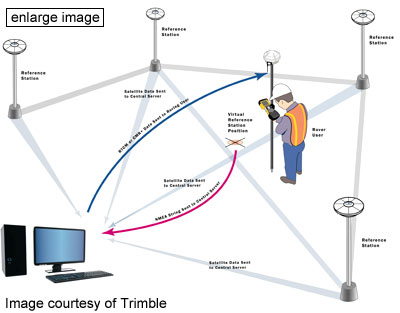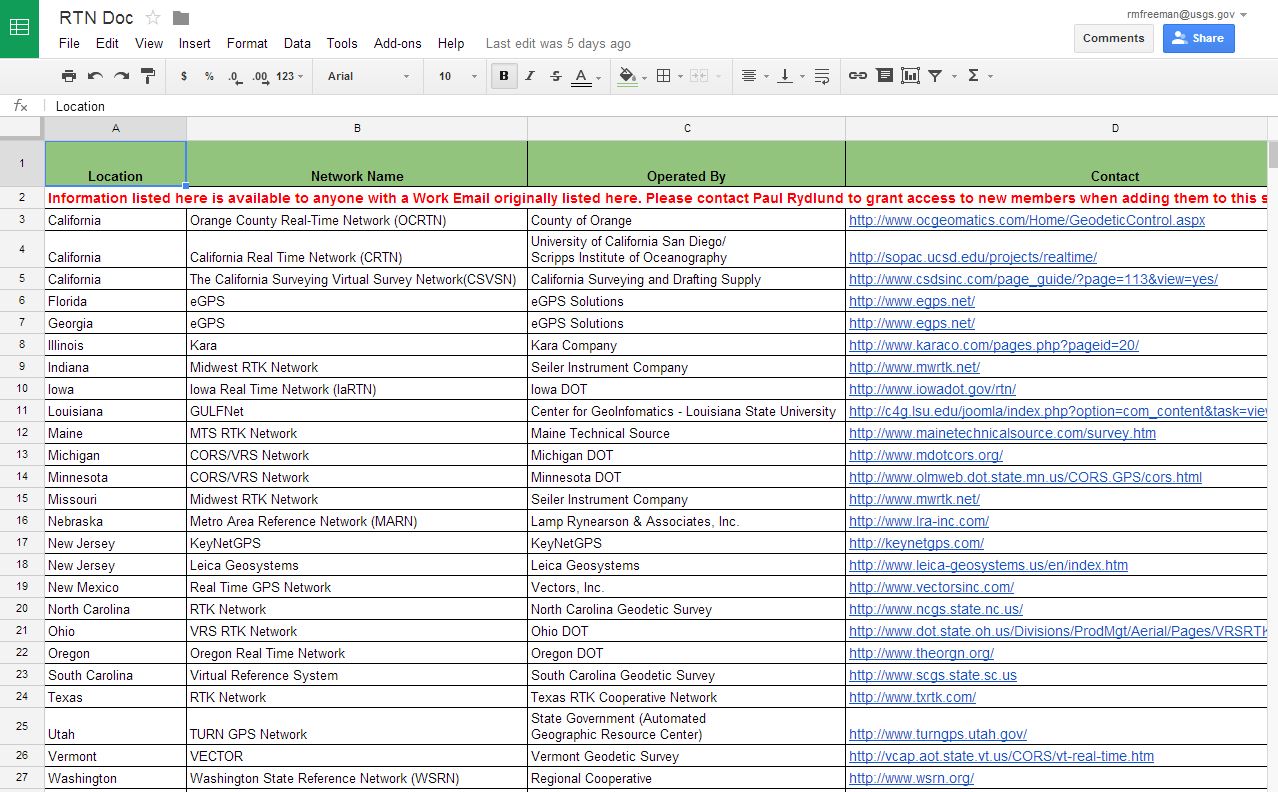
|
Real-Time Network (RTN) Surveying
RTN surveying is similar in concept to Real-Time Kinematic (RTK) surveying in that corrections sent from a base station improve rover positional accuracy in real time. The primary difference is that unlike RTK surveying, where the reference station is physically located at a permanent or semi-permanent location, RTN surveying uses a computed or "virtual" reference station.
General Concept

With RTN surveying, a permanent network of reference stations is required. Spacing of the reference stations can be 10-50 miles and can cover a local, regional, or statewide area. The reference station network continuously streams data (using LAN, Internet, or radio links) to a central location (server). The server then performs several functions including storage of RINEX data, performance of quality assurance checks on the raw data, network modeling and estimation of systematic errors, calculation of and conversion of correction data to a user format (RTCM format or CMR+), and communication of the data to the users. The user then receives the corrections (using LAN, Internet, radio links, or a cellular modem) in real time.
The basic scenario for RTN surveying is a follows:
- The user goes to a work site. The work site preferably is, as with any other style of GPS surveying, physically surrounded by the reference station network.
- The user sets up a surveying job and logs into the RTN system using a cell phone (or other communication method). As part of the login process, the rover sends its position (via a NMEA sting) to the RTN system.
- The RTN system computes a virtual reference station, in close proximity to the rover based on the position sent. Using input from the closest surrounding reference stations, the RTN system then computes and sends corrections as if a real base station were broadcasting from the location of the virtual reference station.
- Using the cell phone, the receiver then obtains and applies the corrections in real time.
After initialization, the survey proceeds in exactly the same manner as an RTK survey. As always, standard survey practices should be followed: stay within the RTN, check accuracy of field-survey results against control points (benchmarks) that surround the work area(s), perform in-field calibration of survey job if necessary, and take redundant, independent readings of a selected number of survey points. Whenever the user moves a set distance (3 to 5 miles) within a set of reference stations or moves into a new area surrounded by a different set of reference stations, a new virtual reference station and corrections are computed. This ensures that small baseline distances are maintained. As with any style of surveying, the accuracy of RTN surveying depends on many factors including the reference station distances, equipment and its settings, survey procedures, and the survey environment. Accuracy typically is in the range of, and in some cases can exceed, that of traditional RTK surveying.
Benefits and Limitations of RTN surveying
Benefits of RTN surveying over traditional RTK surveying include:
- The need for a user to establish a permanent/semi-permanent base station is eliminated. This eliminates the time for initial site selection and (daily) set-up, any issues of security and power supply, and the possibility of set-up errors.
- The RTN can monitor its own integrity and can detect if there is a problem with a particular reference station. With a single-base RTK setup it can be difficult to tell if a problem exists or occurs with a base station while conducting a survey.
- Since the reference stations are part of a network, a loss of one station does not result in failure of the entire network or the resulting survey. Whereas the loss of a reference station with single-base RTK setup results in the end of data collection, with RTN surveying the system accuracy degrades gradually.
- A sufficiently dense reference station network can result in shorter baselines. As with any other style of GPS surveying, shorter baselines result in improved accuracy because of reduced effects of atmospheric interference.
- The RTN reference stations allow for network atmospheric modeling resulting in improved accuracy. With RTK, atmospheric effects are computed using (usually) one location.
- All users of the system are using a common, established reference coordinate frame.
Limitations include:
- There is a high cost of setting up and maintaining the RTN and to use an RTN setup by other organizations there is typically a yearly subscription fee that must be paid for network access.
- Use of the RTN can be limited by cell phone coverage and system down times.
- Availability is dependent on network extent and accuracy can be affected by the network density.
[an error occurred while processing this directive]
Current Real-Time Networks
Linked here is a listing of some available Real-Time Networks. It is not intended to be all inclusive. The list includes public and private organizations and is for descriptive purposes only and does not imply endorsement by the U.S. Government.

Top
|